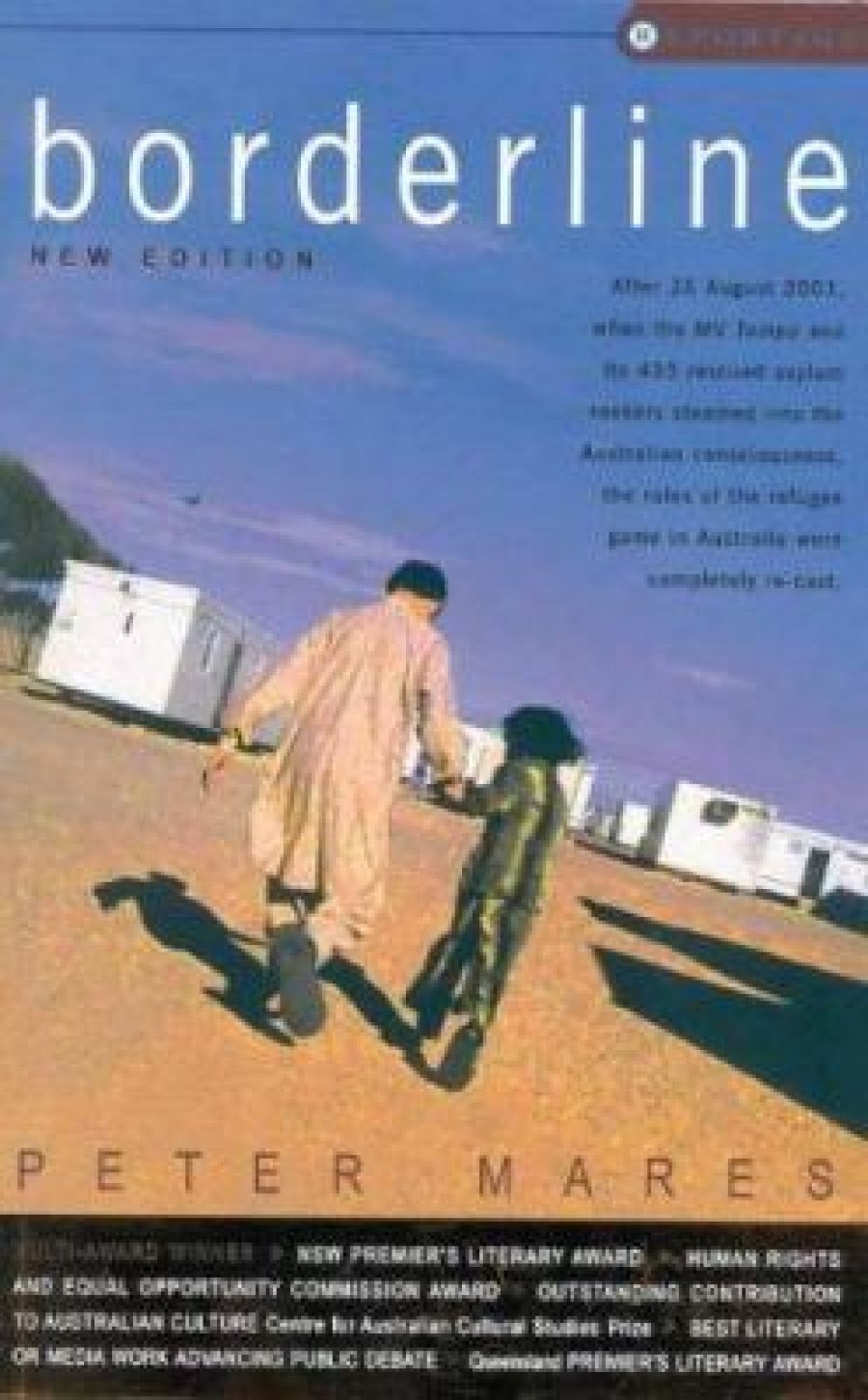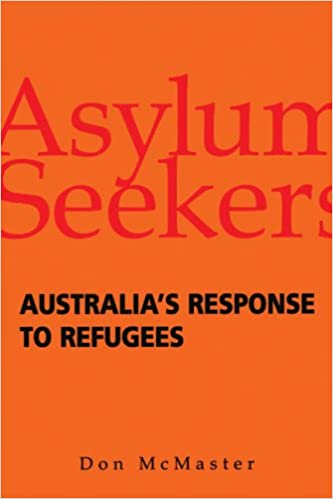
- Free Article: No
- Contents Category: Society
- Review Article: Yes
- Online Only: No
- Custom Highlight Text:
The year 2001 marks the centenary of the Federation of Australia and the fiftieth anniversary of the 1951 Convention Relating to the Status of Refugees. There are important linkages between these milestones. Australian Federation was driven, among other factors, by the desire to gain sovereign control over immigration. Despite the demise of the White Australia Policy and Australia’s early support for the Refugee Convention, Australia’s present-day treatment of refugees and asylum-seekers shows us to be a nation that is still defined in negative terms, through the exclusion of others.
- Book 1 Title: Borderline
- Book 1 Subtitle: Australia’s treatment of refugees and asylum seekers
- Book 1 Biblio: UNSW Press, $29.95 pb, 229 pp
- Book 2 Title: Asylum Seekers
- Book 2 Subtitle: Australia’s response to refugees
- Book 2 Biblio: MUP, $38.45 pb, 254 pp
- Book 2 Cover Small (400 x 600):

- Book 2 Cover (800 x 1200):

- Book 2 Cover Path (no longer required): images/1_SocialMedia/2021/August_2021/41P1jR9JD1L._SX331_BO1,204,203,200_.jpg
These two recent books make welcome critical assessments of Australia’s refugee policies. Peter Mares’s book documents various processes of exclusion, from the mandatory detention of unauthorised arrivals to the problematic implementation of the temporary safe-haven visa scheme for Kosovar Albanians and East Timorese airlifted from Dili. Describing his book as unapologetically journalistic, Mares (with the acknowledged assistance of two legal academics) accurately describes the relevant provisions of the Migration Act in all their complexity. More importantly, Mares investigates the motivation of the policymakers and the impact on asylum seekers, whether it be the trauma of prolonged detention, or the uncertainty of temporary visas, or the deterrence of future unauthorised arrivals. Finally, Mares queries the effect on the existing Australian community of governmental obsession with control at the expense of generosity and compassion.
Mares’s book retained the capacity to shock me, despite the fact that I was well aware of much of what he has to say. Having worked with detained asylum seekers, I had witnessed the debilitating effects of prolonged incarceration. I also knew that many asylum seekers in the community faced destitution. I had played a bit part in the ‘never-ending story’ of the East Timorese litigation, assisting the solicitors for the asylum seekers with some of the ‘arcane’ legal arguments concerning nationality. Yet I was provoked to tears in some places.
Relatively small things upset me. One was the thought of a Somali asylum seeker confronting an immigration detention centre guard at midnight as he barred her way to her crying baby’s refrigerated bottle of formula. (Amnesty International’s recent Mothers’ Day campaign slogan – ‘What are you doing for Mothers’ Day, spending it in detention?’ – also struck a chord.) Other matters, like the full details of the health checks, or lack thereof, for women on temporary safe-haven visas, appalled me. Australia airlifted East Timorese women from the UNAMET compound so as to prevent their being raped and shot, only to send them back, perhaps to die in other ways. Pap smears were not carried out for East Timorese temporary safe-haven visa holders although three tests showed positive results for cervical cancer. Australia shut its eyes to women’s reproductive health problems, when ‘many of the women were now the heads of their households and would return to a hostile environment, and … most had the added burden of young children’.
The book delivers a rare glimpse of the procedure adopted by the Department of Immigration and Multicultural Affairs. It describes a Department of Immigration officer’s interview with an asylum-seeker. The interview consisted of an interrogation about the person’s travel itinerary rather than investigation of the substance of his claims concerning persecution.
The book also offers some insight into the mind of the Minister for Immigration and Multicultural Affairs, Philip Ruddock. In an interview with Mares, the Minister discusses the playoff between people who arrive in Australia to be processed by Australia’s refugee-status determination system and the offshore program for resettlement of people from overseas refugee camps.
‘Why not take 21 million?’ the Minister asked, implying that permitting people to apply onshore would open the floodgates to the entire population of refugees in the world today.
The answer, as Mares states, is that 21 million are not here now and probably never will arrive on Australian shores. Comparatively speaking, Australia receives a pathetically small number of onshore applicants for refugee status. The reality is that about eighty per cent of all refugees are sheltered in developing countries. The Minister’s recent announcement that offshore places have been ‘stolen’ by onshore applicants is quite misleading. It is the Australian government that robs Peter to pay Paul, because it does not want to implement the legal obligations that it has to onshore applicants under the Refugee Convention. The right to seek asylum is seen, quite unrealistically, as a threat to Australian sovereignty instead of protection of both the refugee and Australian society from the morally and legally unacceptable act of returning someone to a place where life and freedom are under threat. The offshore program should be seen as an additional program to implement the moral obligation we owe to countries that are struggling with huge refugee numbers. This moral obligation operates above and beyond our strictly legal obligations not to return someone from Australia to a place of persecution.
The discussion confirms that the Minister thinks it is unacceptable for anyone to claim protection onshore. Refugees should be required to join a ‘queue’ in squalid, dangerous refugee camps in developing countries with insufficient resources to deal with them. In fact, there is no queue. As explained to Mares by a refugee worker, refugees abroad outnumber the places allocated for them and there are too few officers to process them. The right to seek asylum, on the other hand, does exist and there is no good reason why Australia should be able to put itself in the privileged position of acting solely as a country of resettlement.
McMaster takes up the theme of identity. In this published version of his PhD thesis, McMaster documents the White Australia Policy in all its ignominy and draws the link between the construction of the Asian ‘other’ and Australia’s mandatory detention of anyone who arrives without a visa and then seeks recognition as a refugee.
The identity theme is well chosen and I thoroughly agree with McMaster’s analysis. However, I found the use of the terminology ‘other’ both laboured and yet somehow lacking a firm grounding in the post-colonial and post-structural theory from which it is derived. (I realise that some reviewers would think this a laudable feature of the book, but I found it disconcerting.) Meanwhile, the chapter on citizenship (chapter 7, ‘The Politics of Belonging’) sometimes delved too deeply and without firm direction into various theories of citizenship such as semiotic and consumer citizenship.
The subject of citizenship – what it means and what the conditions imposed upon it say about a particular community – is vital to McMaster’s subject, and he makes good use of some of the theories of citizenship. McMaster’s point is that detained asylum seekers are denied not only ‘political citizenship’ in the form of the right to vote (which no one would suggest they have while their claims to remain in Australia are being arbitrated) but also ‘social citizenship’. Social citizenship is denied through the exclusion of asylum seekers from the community, rights to work and so on. However, some of the discussion of citizenship theory could have been more tightly linked to the subject of Australia’s treatment of asylum seekers.
I also thought some sustained analysis of the legal position would have been useful here, and I hope this is not simply a case of professional arrogance. On the whole, I found references to legal concepts such as human rights, the mandate of the United Nations High Commissioner for Refugees, and the role of ministerial discretion in Australia’s system for processing refugees vague and sometimes quite misleading. Most importantly, McMaster could have made more of the finding by the UN Human Rights Committee that Australia’s detention of a Cambodian asylum-seeker amounted to arbitrary detention.
The Committee’s finding in relation to liberty raises questions concerning the denial of other rights that would freely be accessed on release into the community. Like liberty, social and other rights are due to all human beings. So there is a link between the Committee’s ruling and McMaster’s thesis concerning access to social citizenship. The Committee’s ruling is even more clearly linked with McMaster’s thesis concerning identity. Even in a legal system premised on State sovereignty, Australia goes further than permitted in refusing to recognise the common humanity of foreigners and Australian citizens. As McMaster documents, Australia assumes that all asylum seekers pose a threat, thus failing to recognise the potential contribution that most could make as Australian citizens.
Both Mares and McMaster demonstrate through comparative analysis with countries like Canada (McMaster) and Sweden (Mares) that Australia could pursue a different and more humane approach to asylum seekers. Australians should find both books more provocative of real thought about the issue than the rhetoric now spouting from the mouths of most Australian politicians.


Comments powered by CComment